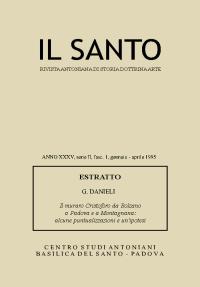Il muraro Cristoforo da Bolzano a Padova e a Montagnana: alcune puntualizzazioni e un'ipotesi.

estratto da "Il Santo", XXXV (1995), 1
SOMMARIO
Attraverso un'indagine condotta su documenti d'archivio, editi ed inediti, l'autore si propone di fornire alcuni elementi utili per una maggiore definizione della figura di Cristoforo da Bolzano, uno dei murari più interessanti tra quelli operanti a Padova nella prima metà del Quattrocento. L'esame di nuove testimonianze permette di chiarire alcune circostanze riguardanti l'origine, la famiglia e le tappe principali del suo percorso professionale, dal lungo impegno nei cantieri del convento e della basilica antoniani fino alla residenza, nell'ultima parte della vita, a Montagnana dove, probabilmente, è incaricato della gestione dell'ambiziosa fabbrica del duomo. Nello stesso tempo la ricerca diventa occasione per soffermarsi a «curiosare» negli ambienti con i quali il muraro più spesso si è trovato in contatto, gli ambienti religiosi mendicanti e in particolar modo francescani, cercando di riconoscere qualcuno dei legami esistenti tra le varie botteghe di artisti ed artigiani che (anche provenienti da altre città, per esempio Venezia) vi si ritrovavano ad operare instaurando tra loro rapporti di collaborazione che venivano poi riproposti anche in altri cantieri del territorio. Nel caso specifico esaminato, rintracciare la presenza di alcuni di questi affermati artifices a Montagnana in anni prossimi a quello della fondazione della nuova chiesa pievana induce a proporre prudentemente !'ipotesi di un loro coinvolgimento in quella fabbrica prima del definitivo arrivo nella città di Cristoforo, che nel frattempo era stato completamente assorbito dai suoi impegni nel complesso antoniano.
SUMMARY
Following research into both the edited and unedited archive documentation, the author hopes to provide useful elements for a greater understanding of the figure of Cristopher of Bolzano, one of the most interesting masons who worked in Padua in the first half of the 15th century. Examination of the new sources helps clarify some of the facts concerning his origins, his family and the main stages in his professional career, {rom the long period of employment he carried out in the Anthonian Basilica and its friary to the residence he worked on during the last part of his life in Montagnana where he was responsible for the management of the building of the cathedral. The author takes advantage of his research "to take a look" at the environments with which the mason had most contact, the mendicant orders and, in particular, the Franciscans, in an attempt to identify some of the links that existed between the various artists' and artisans' studios (not only in Padua, but also in other cities like Venice) and that found themselves working together on other building sites in the territory. In this specific case, the identification of the presence of some of these established artifices in Montagnana in the years following the foundation of the new parish church gives rise naturally to the hypothesis of their involvement in the building work before Christopher, having completed his commitments in the Anthonian complex, finally arrived in the city.

